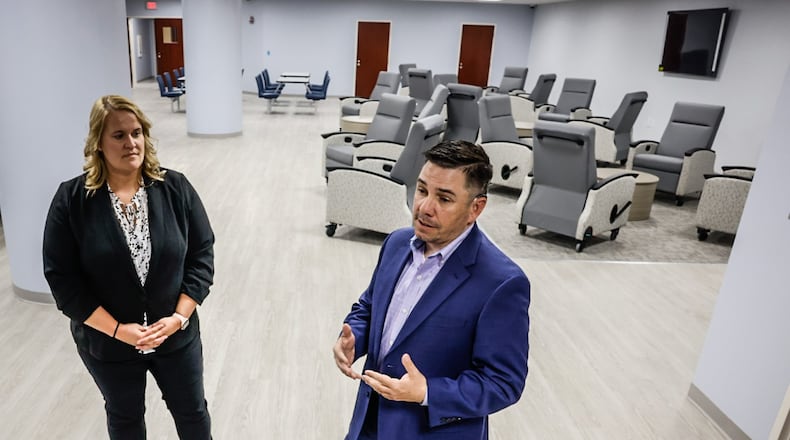The Dayton Daily News examined local efforts to reduce the number of people held in the Montgomery County Jail who may be dealing with a mental illness or substance use disorder. Officials are trying crisis intervention and increased accountability when it comes to monitoring individuals ordered to undergo mental health treatment by a court.
“It’s clear that people who are sick with mental health or addiction struggles don’t belong in a jail,” said Joel Pruce, a coordinator with the Montgomery County Jail Coalition.
“So to the extent that we can build community-based services of support for these individuals without entangling them in the criminal legal system, the better off we all are.”
Mental health needs in the jail
About 2 million times each year, people with serious mental illness are booked into jails across the U.S., according to the National Alliance on Mental Illness.
More than 40% of jail inmates have a history of mental illness, many of whom are held for committing non-violent, minor offenses related to the symptoms of untreated illness — such as disorderly conduct, loitering, trespassing, disturbing the peace— or for offenses like shoplifting and petty theft.
There were 576 people in the Montgomery County Jail as of Wednesday, which is down from a recent high of 863 in August 2018.
The jail has previously faced issues housing those who are experiencing mental health crises or dealing with a substance use disorder.
“Our biggest challenge is structural,” said Teresa Russell, director of criminal justice and outreach services at the Montgomery County Sheriff’s Office. “Any facility built in 1965 like ours was really not designed to house individuals with severe mental health and addiction issues.”
If there is a person who is incarcerated at the jail verbalizing suicidal or homicidal thoughts, Russell said the jail has nowhere to house them outside of the observation cells on the first floor booking area, which she said is the jail’s “busiest, wildest area.”
“It’s not a therapeutic area for someone who’s in that type of crisis,” Russell said. “Even for someone who’s detoxing from substances, we’ve struggled with having the ability to house them without having them all the way across the jail in different classifications.”
Jail-based assessments
Getting people from the jail and into treatment more quickly has been is a tactic county partners could increase..
Montgomery County Alcohol, Drug Addiction, and Mental Health Services (ADAMHS) has traditionally provided assessments as inmates left the jail, according to ADAMHS executive director Helen Jones-Kelley. Toward the end of last year, county agencies sought to make changes to the jail assessments, including doing them even before inmates were leaving the jail..
“As the community entity, we were providing assessments to reconnect people to services as they exited the jail,” Jones-Kelley said.
In August of last year, the general division judges of the Montgomery County Common Pleas Court sent a letter to Montgomery County ADAMHS and its board asking for changes to be made to those assessments. Among the requests for changes was that the vendor providing assessments to the jail should be a neutral party that cannot refer offenders to itself.
Nova Behavioral Health previously held the contract through ADAMHS for providing jail assessments. According to the letter from the general division judges, Nova referred 73% of assessed offenders to itself in 2019. That number was 73% in 2020, 72% in 2021, and 57% for as of August of last year.
The jail found that inmates were getting backed up at the jail waiting for beds to become available at Nova, Russell said.
Changes made
Naphcare took over that contract for jail-based assessments starting in January. The Naphcare contract was approved for a maximum contract price of $167,400 funded by ADAMHS.
“It has prevented waitlists getting into one or two treatment agencies,” Russell said.
Naphcare also has access to medical records, so the jail is not relying on inmates to self report their own mental illnesses.
By having a neutral party make referrals to more agencies in the community, Russell said they are starting to see fewer of the same people returning to the jail.
“We also don’t see the same people coming back over and over again because they’ve only been to the same treatment agency over and over,” Russell said. “They’re getting opportunities to try different services in different agencies they’re deemed eligible for.”
Opportunities for diversion
Crisis interventions, such as the Crisis Call Center, the crisis response team and the soon-to-exist Crisis Receiving Center are part of a tri-fold effort to prevent individuals going through a mental health crisis from having to interact with law enforcement or go to jail.
The Crisis Call Center, which can be reached at 833-580-CALL (2255), is operated by RI International, a mental and behavioral health services non-profit. Since it started taking calls in January 2022, it has received more than 18,000, with 89% of the calls being resolved over the phone. The average time on the call is 14 minutes, and 0.63% of the calls get transferred to 9-1-1.
The mobile crisis response team has also made more than 1,000 responses, with 85% being resolved in the community and 12% requiring responses from law enforcement.
“We have to suspend our myths about people with mental illness,” Jones-Kelley said. “One of the things we’re trying to do is to help make that very clear delineation between who needs to be served within the criminal justice system, who needs to be served within the mental health system, especially right now because we have so many people with significant mental health needs.”
The Montgomery County Crisis Receiving Center, located at 601 S. Edwin C. Moses Blvd. in Dayton, will be opened later this summer by RI International and Montgomery County ADAMHS. The non-profit covered the cost of bringing the Elizabeth Place property online, and Montgomery County ADAMHS invested $2.3 million in federal, state and local dollars to fund the call center and the mobile crisis response teams, according to ADAMHS.
“Mental health crisis is when a person can no longer control and they become really potentially harmful to themselves or to other people to the point where they may even become physically aggressive,” Jones-Kelley said.
The Crisis Receiving Center will also be able to provide assessments for individuals to determine if their behavior is the result of a mental health crisis or if it is criminal behavior with which law enforcement would need to be involved.
“There are times when people are acting out violently in the hospital because it’s criminogenic factors, but sometimes it’s a criminogenic factor matched with a mental illness,” Jones-Kelley said. “Rather than our citizens just trying to figure, they can take people there (the Crisis Receiving Center), and if it’s a true violent situation, you really don’t want that in the emergency room.”
Task force, Familiar Faces
Earlier this year, Montgomery County launched a task force to address behavioral health issues that have risen dramatically in the area since 2019.
In January, the county partnered with the Greater Dayton Area Hospital Association for behavioral health consulting services. A report from the task force with findings and recommendations is not expected until the fall.
Montgomery County ADAMHS also has an initiative looking at individuals who are touching multiple systems of care and/or county agencies and sharing data across those systems.
Familiar Faces, which they began discussing in July 2022 and launched in January, brings local teams together to create plans for treatments to try to reduce the burden on the justice system.
“There are people who touch multiple systems. They may or may not be restricted to mental health and criminal justice, so we invited a very broad group to our initial meetings to talk about who needs to be at the table, what systems need to be able to share data, and how might we come around that,” Jones-Kelley said.
Taking a different approach
Others are calling for additional measures to be taken to reduce the jail population, including bail and pre-trial justice reforms.
“Misdemeanor drug charges awaiting trial do not need to be held in a jail,” Pruce said. “By many calculations, from a half to two-thirds a county jail population is being held pre-trial.”
By issuing a court summons instead of incarcerating someone in the jail to await trial, those individuals can keep their jobs while while also maintaining family responsibilities or potentially starting or continuing treatment for a substance use disorder if that is applicable to them.
“When people go into jail ... their world will crumble around them,” Pruce said. “They will miss payments on things, they will get fired from jobs…all these things will spiral from petty charges, not convictions.”
Staff Writer Sydney Dawes contributed to this story.
About the Author

